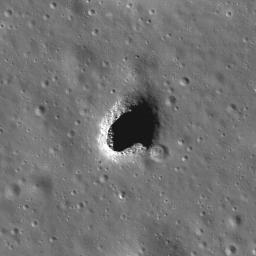
|
Depths of Mare Ingenii
- Click the image above for a larger view
- Full-Res JPEG (1000 x 1000) (112.1 kB)
- Full-Res TIFF (1000 x 1000) (1.0 MB)
Caption:
Mare Ingenii may be best known for its prominent lunar swirls, which are high albedo surface features associated with magnetic anomalies. However, lunar swirls are not the only unique geologic feature found in the farside "sea of cleverness." The high-resolution cameras aboard the Japanese SELENE/Kaguya spacecraft first discovered this irregularly-shaped hole, visible in the this image at LROC's 0.55 meter/pixel resolution. The boulders and debris resting on the floor of the left side of the pit are partially illuminated and probably originated at the surface, falling through the pit opening during collapse. Impact craters are visible everywhere on the Moon, but pits are rare. This pit in Mare Ingenii (located at -35.9°N, 166.0°E) is about 130 meters (427 feet) in diameter. Image width is 550 meters (1804 feet), illumination is from the upper right, NAC M128202846LE.
Background Info:
NASA's Goddard Space Flight Center built and manages the mission for the Exploration Systems Mission Directorate at NASA Headquarters in Washington. The Lunar Reconnaissance Orbiter Camera was designed to acquire data for landing site certification and to conduct polar illumination studies and global mapping. Operated by Arizona State University, LROC consists of a pair of narrow-angle cameras (NAC) and a single wide-angle camera (WAC). The mission is expected to return over 70 terabytes of image data.
Cataloging Keywords:
| Name | Value | Additional Values |
|---|---|---|
| Target | Moon | |
| System | Earth | |
| Target Type | Satellite | |
| Mission | Lunar Reconnaissance Orbiter (LRO) | |
| Instrument Host | Lunar Reconnaissance Orbiter | |
| Host Type | Orbiter | |
| Instrument | Lunar Reconnaissance Orbiter Camera (NAC) | |
| Detector | Narrow Angle Camera (NAC), Wide Angle Camera (WAC) | |
| Extra Keywords | Crater, Grayscale, Impact, Magnetosphere | |
| Acquisition Date | ||
| Release Date | 2010-06-16 | |
| Date in Caption | ||
| Image Credit | NASA/GSFC/Arizona State University | |
| Source | photojournal.jpl.nasa.gov/catalog/PIA13224 | |
| Identifier | PIA13224 | |
